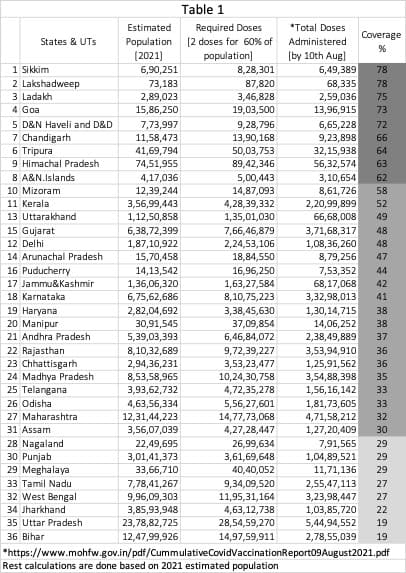6 min read
It is assuring to see the fall in number of COVID-19 positive cases, and increase in the vaccination coverage. Maharashtra became the first state to fully vaccinate over a crore people and Bhubaneswar became the first city to vaccinate its hundred percent population. Many more such states and districts will accomplish their vaccination coverage goals in the coming months, but learning from India’s ‘Universal Immunization Program’ (UIP) on full immunization coverage (FIC), tells us that all states and districts may not be able to vaccinate their population with the same speed against covid-19 due to the various bottlenecks involved; scarcity of healthcare infra & trained human resources especially in the hard to reach areas, and vaccine hesitancy due to the lack of awareness are some of them.
Every year UIP targets around 26 million infants and 29 million expecting mothers, in-fact it is the world’s largest. However, immunization coverage among children aged 12-23 months has increased at a very slow pace of 1 percent each year from 35 percent in 1992-93 to 62 percent in 2015-16. To address this slow progress ‘Mission Indradhanush’ and ‘Intensified Mission Indradhanush’ were launched in 2014 and 2017 respectively. The Ministry of Health and Family Welfare (MoHFW) had also came up with a guiding document for states in 2019 – ‘A roadmap for achieving 90 per cent full immunization coverage in India’ which puts districts in three categories, in terms of full immunization coverage – [i] 91 districts below 50 percent [ii] 555 districts between 50-90 percent and [iii] 54 districts more than 90 percent.
If one looks at state wise vaccination coverage against COVID-19, similar trends are emerging. This will make it a daunting task to vaccinate 60 percent of India’s population with two doses, a threshold required to achieve herd immunity as per various health experts. Out of the 51,45,00,268 cumulative doses administered till 10th August,2021 states can be bucketed in three categories, in terms of 60 percent vaccination coverage: [i] 11 states below 30 percent [ii] 20 states between 30 – 60 percent [iii] 13 states more than 60 percent (Table 1). Therefore, improving vaccination coverage should be everyone’s priority, especially targeting districts & states where coverage is less. Though many organizations showed agility and vaccinated their employees. but such initiatives need to be extended to the community as well to speed up the process.
One such community drive was recently organised at Srikakulam district of Andhra Pradesh by Dr. Reddy’s Foundation, in close partnership with the district administration, a charitable hospital, and the initiative is funded by a philanthropist. This article captures the key learnings so that it may be helpful for other agencies who are planning to augment the government’s ‘National COVID-19 Vaccination Program’.
Multi stakeholder collaboration is required
Organising any COVID-19 vaccination drive for the community is a highly technical process and it has to be done in close collaboration with district administration. The lead NGO needs to tie-up with the right charitable hospital who should have the required licenses to procure vaccine, CVC number, proper infra to maintain the cold chain and a trained team to administer the vaccine.
Procurement of vaccine
NGOs can’t procure vaccines, it requires appropriate licenses. Therefore, if NGOs are raising grants in the name of vaccination drive, they have to pass it on to the partnering hospitals for vaccine procurement. Based on the nature of grant – local or foreign, appropriate process should be followed, else it may disrupt the entire effort. In the case of Dr. Reddy’s Foundation we used Sputnik -V and procurement was slightly easy due to the procurement and technical guidance provided by Dr. Reddy’s team. Accordingly agencies should have a plan in place on – which vaccine they will procure, how they will procure etc.
Training & capacity building
Successful completion of any vaccination drive, including COVID-19 vaccination drive, largely depends upon the quality of training conducted for human resources involved. The partnering hospital will certainly take care of this aspect but chances are that their own vaccination programmes must be on, so onboarding & training new resources may be required. Due to the sudden need for a vaccination programme at this scale, many healthcare workers have to be on-boarded and their training needs to be conducted. Many of these healthcare workers may not be involved in routine immunization programmes, hence this training and capacity building aspect can’t be ignored.
Managing the logistics
Transportation of vaccines from inventory to the partner hospital, setting up appropriate infra at the hospitals -such chest freezers, data loggers, internet connection, 24 hours power backup are super critical. Team members need to be trained accordingly on all those processes. Any process violation will have an impact on the efficacy of the vaccine.
Planning outreach
This is an important area of intervention when you want to reach areas that are difficult to access or have high risk populations. NGOs / volunteers can play a very important role in creating awareness. The District Administration and local NGOs’ support helped us reach out to the fishing community and other vulnerable populations of Srikakulam area.
Administering the vaccine
In our case, the partner hospital and medical college had all the required infra & systems in place. Generally the place should have a waiting room/ area, vaccination room and observation room and a recommended vaccination team. A comprehensive guideline, including guidelines on COVID-19 vaccination at workplaces are issued by the government of India, which must be followed.
Adequate arrangement for management of adverse events
The partner hospital has to take care of this important aspect, and make appropriate arrangements. This should be as per the revised AEFI guidance issued by the Ministry of Health and Family Welfare.
Managing the vaccine wastage
Vaccine wastage is an area of concern. As per May month report, in one state vaccine wastage was as high as 33 percent, MoHFW expectation is to keep it within 1 percent. In fact in the month of May states like Kerala and Odisha set an example for others by having negative wastage. As every Covishield and Covaxin have one extra dose to account for wastage, trained vaccinators have been extracting this one extra dose. In our case it was relatively easy as each Sputnik-V vile has a single dose, which helped us manage wastage within .001 per cent.
Monitoring the programme
This is easy, unlike spending hours to bring alignments on ROI of social development programmes. All those who take COVID-19 vaccine in India will have to get registered on the CoWIN app, a commendable effort by the government which made monitoring easy.
Conclusion
The key learning from Srikakulam vaccination drive is that the large-scale, multi stakeholder collaborations among district administration, philanthropist, NGOs, charitable hospitals and CSRs can give a much needed push to India’s vaccination program. Revised guidelines of ‘National COVID Vaccination Program’ also talks of non-transferable electronic vouchers (now launched as e-RUPI) to enable people to financially support the vaccination of economically weaker sections at private vaccination centres. We all have a role to play and most importantly vaccination against covid-19 has positive externalities, which will benefit everyone.



















